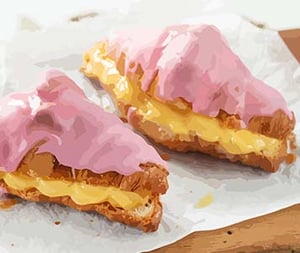Concerned bakers: is the inventor of the crompouce within her rights?
 The crompouce is causing quite a stir. Its inventor, Ulrika Menig, is threatening to go to court. She wants to stop others from making her pastry and selling it under the same name. Yesterday, our Patent Attorney Robbert-Jan de Lang explained on Hart van Nederland that the name 'crompouce' is indeed protected because it is a brand name but that this is not the same as a patent. Menig nevertheless stands a chance of winning if she decides to go to court. That is because we found out that she also has a design right, which protects more than simply the brand name.
The crompouce is causing quite a stir. Its inventor, Ulrika Menig, is threatening to go to court. She wants to stop others from making her pastry and selling it under the same name. Yesterday, our Patent Attorney Robbert-Jan de Lang explained on Hart van Nederland that the name 'crompouce' is indeed protected because it is a brand name but that this is not the same as a patent. Menig nevertheless stands a chance of winning if she decides to go to court. That is because we found out that she also has a design right, which protects more than simply the brand name.
Protection of appearance
Here is a quick crash course in design law. You can apply for a design on the external features of a product such as the characteristic appearance of a sports car, a piece of furniture or a food product, for instance, by means of a design registration. With a design others are not allowed to make this product with the same appearance. So it is not about the name, crompouce in this case, but purely about what it looks like. A design therefore contains drawings and photographs. These say something about the shape, materials and colours. If a competitor then makes a product that looks the same or is very similar then this is an infringement. So it does not even have to be an exact copy.
Back to the compouce. I am no judge, but because I find it interesting to try and figure out what Menig's chances are I decided to take a look at the design application she filed.
Compare a crompouce, a croissant and a tompouce
The first thing a judge would look at is what the differences are between the design registration of the crompouce and the products that already existed? The most obvious products are, of course, the croissant and the tompouce. I expect that there is enough of a difference there. After all, it is purely about the design and not, for example, about whether the ingredients were already known.
Italian croissant
The baker in the Hart van Nederland piece says that the crompouce originated in Italy. The croissant in the piece does indeed have similar ingredients, but looks distinctly different. It is greener in colour and the shape is also different. I therefore wonder if it could render Menig's design invalid.
In the design application, a conscious decision was made to opt for a pink glaze. There is nothing green about that. On top of that the croissant used in the design application is a straight one. How does a judge view a crescent-shaped crompouce? I can also imagine that if, for instance, the croissant were to be cut open differently or the cream were to be injected in a different way, the overall look would still be similar.
What's next?
If bakers want to err on the side of caution they might want to invest in a licence. In return for a fee you then get permission to market the crompouce. This is what Bakkerij van Maanen, for example, decided to do recently. This baker pays Menig and is therefore allowed to make and sell the crompouce under that name.
Court case
The baker on Hart van Nederland seemed to be less concerned about things and so it might eventually come to a court case. In that case, I suspect the accused baker's lawyer will have a tasty job ahead of them as it will ultimately all depend on what was known before the design registration. So the lawyer will have to go in search of as many similar pastries as possible. That seems like a job for a real foodie.

About the author
I studied mechanical engineering and materials science at Delft University. I joined EP&C as a trainee patent attorney in 2015 and qualified as a Dutch and European Patent Attorney in 2021. In...
More about Thomas >